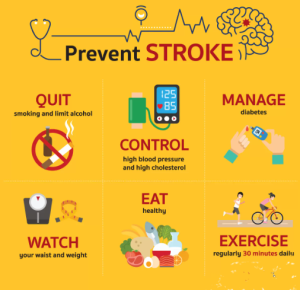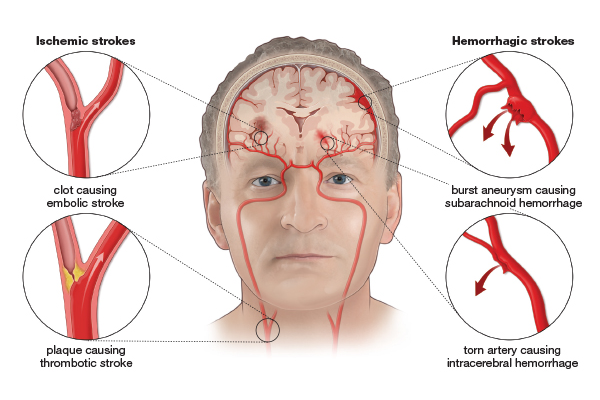A stroke is a serious life-threatening medical condition that happens when the blood supply to part of the brain is cut off.
According to vascular neurologists, strokes are a medical emergency and urgent treatment is essential. “The sooner a person receives treatment for a stroke, the less damage is likely to happen,” says family physician, Dr. Sewuese Saakwen.
Saakwen explains that vascular neurologists specialize in diagnosing, treating and managing conditions of cerebrovascular disease, which are conditions that affect the blood vessels in the brain and spinal cord.
those who have had stroke in the past, or if one of their parents had a stroke, are at a much higher risk of having a future stroke
“Stroke is the most common cerebrovascular disease, hence the ‘stroke doctor’ nickname,’ she adds.

Physicians warn that many of the stroke risk factors are pretty silent (like high cholesterol and high blood pressure) ― until they’re not, hence the need for people to be mindful of maintaining healthy habits that can put stroke at bay.
“But just because some of the risk factors aren’t always obvious doesn’t mean strokes can’t be controlled,’ says Dr. Chiedu Mokogwu; adding, “In fact, it is estimated that 80% of strokes are preventable through lifestyle changes like exercise, diet and more.”
Here, we share the unhealthy habits experts want you to avoid because they heighten the risks for stroke.
regular physical activity helps keep your blood vessels clog-free

Sedentary lifestyle
According to Dr. Arthur Wang, director of endovascular neurosurgery at Tulane University School of Medicine, one of the modifiable risk factors for stroke is having a sedentary lifestyle.
In general, sedentary lifestyle means spending too much time sitting or lying down and not enough time exercising or moving around.
“It’s been shown that regular physical activity helps keep your blood vessels clog-free. It stops the buildup of plaque in the arteries,” Wang said. “And so we generally recommend that people get probably 30 minutes of moderate exercise maybe five times a week.”
sedentary lifestyle means spending too much time sitting or lying down and not enough time exercising or moving around
This could mean going for walks, runs, biking, gardening or joining a group workout class — there is no wrong way to get moving.

Ignoring high blood pressure
“It turns out that a lot of the same things that we would recommend for a healthy lifestyle also reduce the risk of both heart disease and stroke,” Mokogwu said. “But if there’s one factor that is the most impactful, it would be blood pressure.”
Elevated blood pressure, particularly over time, can lead to problems, he said: High blood pressure is the biggest modifiable stroke risk factor.
“If you took a magic wand and waved it and suddenly eliminated high blood pressure from the population, there would be fewer strokes,” the physician said; adding, “It’s by far the leading risk factor for stroke and we call it the silent killer because oftentimes, patients don’t feel it; you have to have it checked and monitored and treated.”
High blood pressure is the biggest modifiable stroke risk factor
 Skipping regular check-ups
Skipping regular check-ups
“These risk factors oftentimes don’t have any real symptoms,” Saakwen warns, which is a worrisome thing to think about. “A patient would never know that their blood pressure is high, they wouldn’t know whether they have high cholesterol unless all of this is routinely tested or screened on a regular basis.”
This means it’s crucial that you visit your primary care doctor for the routine check-ups that they deem necessary. They’ll screen you for issues like high cholesterol and high blood pressure while checking other risk factors like your blood sugar and weight, too, she added.
it’s crucial that you visit your doctor for the routine check-ups that they deem necessary
“I think just being hyper-vigilant about those things, especially when these risk factors for stroke don’t manifest in any real symptoms, so it’s really important for patients to understand that so they take the actionable steps to see their doctor to get these routine screening tests,” Mokogwu said.
Your doctor can also review any risk factors outside your control, like gender (strokes are more common in women, experts warn), race (they’re more common in Black people, they say) and personal history.
“In terms of previous medical history, those who have had prior strokes in the past, or if one of their parents had a stroke in the past, are at a much higher risk of having a future stroke,” the doctor said.
 Smoking
Smoking
According to the physicians, one of the habits that is high on a to-avoid list is smoking.
“That definitely increases the risk of stroke, and heart disease, for that matter,” Saakwen said.
“And one of the ways that it does that is by causing the blood vessels to become narrowed over time, and that can ultimately lead to blockages in blood flow to part of the brain, which is essentially what a stroke is,” she explained.
 Drinking too much alcohol
Drinking too much alcohol
Centres for Disease Control and Prevention says you’re probably aware that alcohol is not good for you, because it’s linked to certain kinds of cancer, liver disease, and yes, stroke, too.
Specifically, doctors say there is an association between excessive alcohol use and heart disease and stroke risk.
there is an association between excessive alcohol use and heart disease and stroke risk
Alcohol recommendations vary by person, but, the CDC considers more than four drinks in one sitting for women or five drinks in one sitting for men to be excessive drinking. More than eight drinks per week for women and 15 drinks per week for men is also considered excessive drinking.
Generally, it’s accepted that women should not have more than one alcoholic drink a day and men should not have more than two.

Ignoring your diet
A proper diet is important for managing stroke risk, too. This means moderating foods that are full of saturated fats, sugar and salt, doctors say. They warn that there is a relationship between salt intake and high blood pressure, which is another stroke risk factor.
When it comes to what you should eat, nutritionists urge us to eat food, mostly plants. “This means having a diet that’s rich in fruits and veggies, with some meat added in.”
Dismissing necessary treatment
Since strokes are so common, CDS says it’s important that you’re aware of the signs and get treated as soon as possible. Available stroke treatments work better the sooner they’re done, the Centre says.
“Because many strokes aren’t painful, and the symptoms of stroke vary so much, it’s important to recognize symptoms of stroke,” doctors say.

And, there’s a useful acronym to help people remember the signs — and that acronym is FAST, doctors say. FAST stands:
- Facial drooping
- Arm weakness
- Speech difficulty
- Time to call 9-1-1, according to the American Stroke Association website.
“These are not the list of all potential stroke symptoms, but any one of those [factors] raises the suspicion that it could be a stroke, especially if it happens suddenly,” Mokogwu advised.
Caveat
It’s important to remember that getting treatment as fast as possible is vital. So, if you feel unwell, don’t hesitate to visit the nearest hospital.
This article is adapted from HuffPost.


